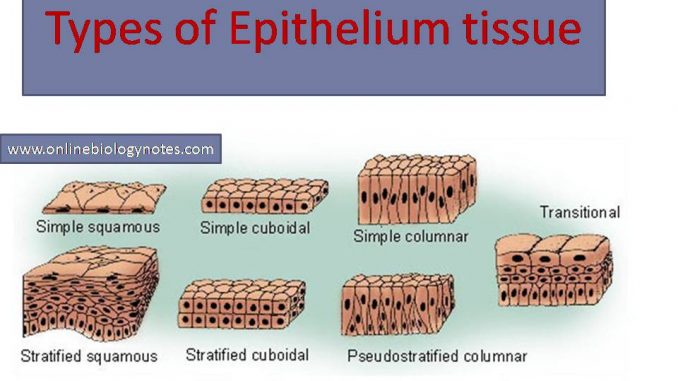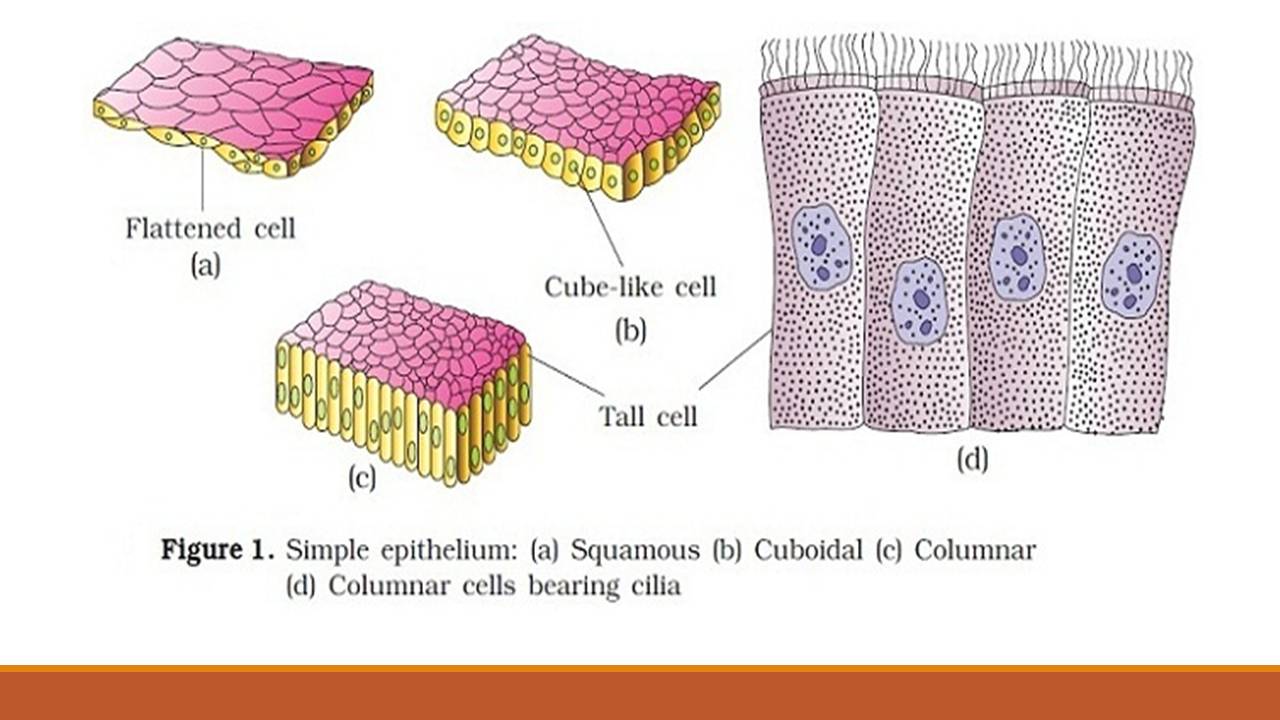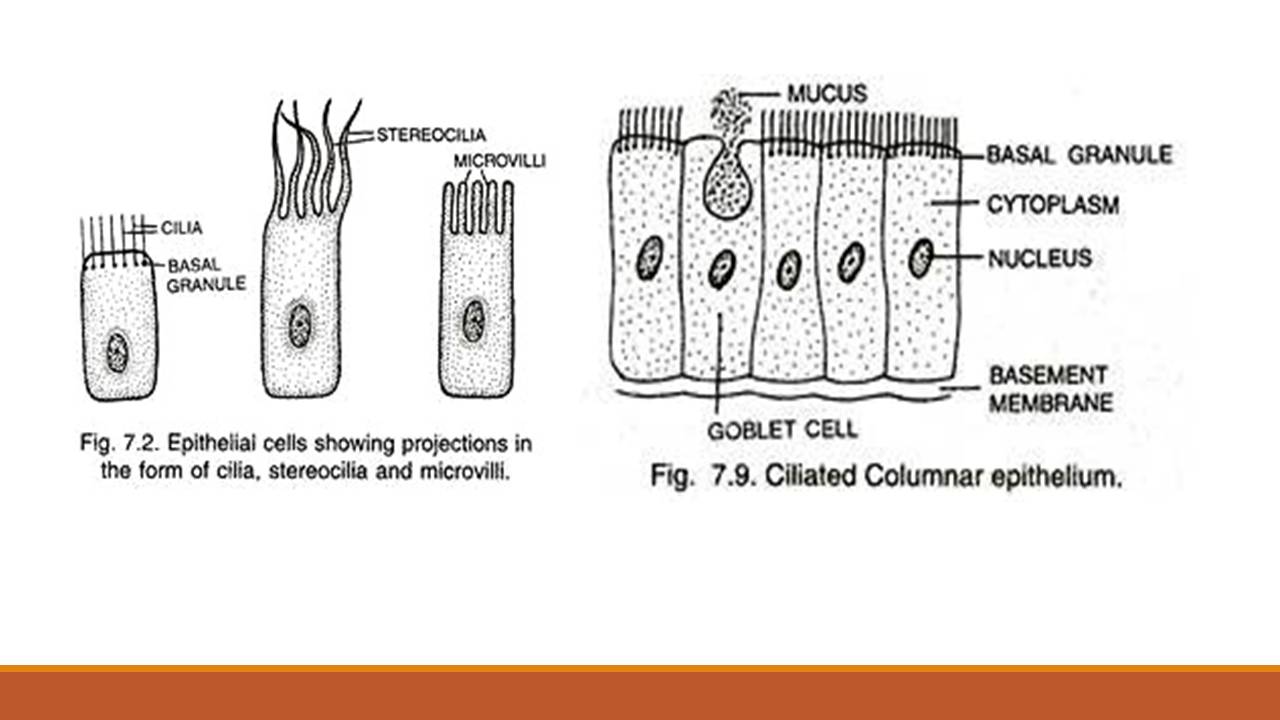
I. simple epithelium
II. compound epithelium
III. Specialized Epithelium
I. Simple epithelium tissue
- Simple squamous epithelium
- Simple cuboidal epithelium
- Simple columnar epithelium
- Pseudo-stratified epithelium

1. Simple squamous epithelium
- consist of a single layer of flattened cells
- Margin of squamous cells are irregular
- Occur as tiles on a floor, also known as pavement epithelium
- Comprises lining of body cavity, cardiovascular and lymphatic systems,
- surface of coelom, buccal cavity, nasal cavity, alveolar lining of lungs lung and bowman’s capsule of kidneys (gas and liquid exchange)
- Function = protection, absorption, diffusion and filtration
2. Simple cuboidal epithelium
- -consists of a single layer of cells that are roughly square in shape when cut in cross-section. Each cell has a spherical nucleus in the centre
- forms lining many ducts and tubules of the body.
- Functions of secretion and absorption e.g. kidney
- Cuboidal epithelium is commonly found in secretive or absorptive tissue: for example;
- (secretive); exocrine gland the pancreas.
- (absorptive); lining of the kidney tubules.
- in the ducts of the glands.
- germinal epithelium; lining of ovary and testis.
3. Simple columnar epithelium
- Cells are elongated and column-shaped. Their nuclei are elongated and are usually located near the base of the cells.
- Columnar epithelium is found in the following:
- The lining of the stomach and intestines.
- Some columnar cells are specialized for sensory reception such as in the nose, ears and the taste buds of the tongue.
- Also have surface modifications such as cilia and microvilli and
- Goblet cells (unicellular glands) are found between the columnar epithelial cells of the duodenum.
- Function: secretion and absorption.
4. Pseudo-stratified epithelium:
- These are simple columnar epithelial cells whose nuclei appear at different heights, giving the misleading (hence “pseudo“) impression that the epithelium is stratified when the cells are viewed in cross section.
- Found in lining of respiratory tract, urinary tract, vas deferentia, epididymis
- Pseudo-stratified epithelium also possess fine hair-like extensions of their apical (luminal) membrane called cilia. In this case, the epithelium is described as “ciliated” pseudostratified epithelium.
- Ciliated epithelium is found in the:
- Airways (nose, trachea and bronchi).
- Uterus and Fallopian tubes of females.
II. Compound or Stratified epithelium:
- Stratified squamous epithelium
- Stratified cuboidal epithelium
- Stratified columnar epithelium
- Transitional epithelium
1. Stratified squamous epithelium
- Stratified squamous epithelium consists of multiple layers, with squamous cells at the apical surface.
- The primary function of this type of epithelium is protection.
- Aeas subject to abrasion, like mouth, esophagus and skin, have stratified epithelium.
- Stratified Squamous epithelium are of 2 types
- i. Keratinized stratified epithelium
- ii. Non-keratinized stratified epithelium

i. Keratinized Stratified epithelium:
- The Epidermis (most superficial layer) of the skin is composed of stratified squamous epithelial cells that contain large quantities of the protein
- Keratin is a tough fibrous protein that offers protection from abrasion and water loss.
- New cells are produced at the basal membrane of the epithelium and are gradually pushed towards the apical surface. As they move upwards, they become filled with keratin and eventually die, forming a layer of dead, keratin filled cells on the apical surface of the epidermis.
- The dermis, which lies deep to the epidermis, is composed of connective tissue.
- Functions- Impervious to water, resistant to mechanical damage.
ii. Non-keratinized stratified epithelium:
- These are Layers of living squamous epithelium formed by cuboidal cells
- Found in moist surface like, buccal cavity, oesophagus, vagina
- Functions– protection from mechanical damage
2. Stratified cuboidal epithelium:
- Stratified cuboidal epithelium consists of multiple layer of cell where the outermost layer of cells is cuboidal in shape.
- Found in conjunctiva of eyes, lining of ducts of sweat glands, salivary gland, mammary glands and urethra.
- Function– Protection against mechanical and chemical stress
3. Stratified Columnar epithelium:
- Stratified columnar epithelium consists of multiple layers of cells where the outermost layer of cells are columnar in shape, Middle layer is cuboidal.
- It forms lining of vasa-differentia, respiratory tract and mammary gland.
- Function– secretion of fluids and protection from mechanical and chemical stress.
4. Transitional epithelium:
- Transitional epithelium consists of layers of cells which are similar in size and may be flattened at the top and have the capability to modify the shape.
- Cells are living, large and stretch to change its thickness.
- Found in areas that are subjected to stress condition such as- urinary bladder, ureter, renal pelvis.
- Function-expansion of the organ, prevent loss of water form blood and prevent escape of urine to surrounding tissue.
III. Specialised Epithelium
- Glandular epithelium
- Germinal epithelium
- Sensory epithelium
- Ciliated epithelium

1. Glandular epithelium:
- Glands are composed of cuboidal and columnar epithelium and are specialized for secretion. They secrete enzymes, hormones, mucus etc.
- Based on the no. of cells, glands are of two types;
- Unicellular gland- individual cell is modified into glandular cell, eg. Goblet cell
- Multi cellular gland- Number of glandular cells are aggregated to form multicellular gland
2. Germinal epithelium:
- These are cuboidal or columnar epithelium layer found in the gonads. Eg, ovary and seminiferous tubules
3. Sensory epithelium:
- These are modified columnar epithelium having sensory hair (cilia) at the free surface lies between columnar epithelium.
- They perceive the stimulus,. Found in nasal cavity and tongue
4. Ciliated epithelium:
- These are elongated columnar epithelium having numerous cilia at the free end.
- Found in Ureter, respiratory passage, spinal cord, oviduct etc.
